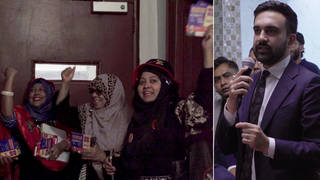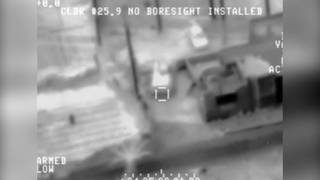
Amnesty International is accusing the United States of covering up civilian casualties in its secretive air war in Somalia targeting the militant group al-Shabab. The U.S. has carried out over 100 strikes in Somalia since 2017. For years the Pentagon has claimed no civilians were being killed in the airstrikes, but the new Amnesty report found that at least 14 civilians were killed, and eight more were injured, in just five airstrikes. The overall civilian death toll is likely to be far higher. We speak with Brian Castner, Amnesty International’s senior crisis adviser on arms and military operations. He helped write Amnesty’s report, titled “The Hidden US War in Somalia.”
Transcript
NERMEEN SHAIKH: Amnesty International is accusing the United States of covering up civilian casualties in its secretive air war in Somalia targeting the militant group al-Shabab. The U.S. has carried out over a hundred strikes in Somalia since 2017 as part of a military campaign involving Reaper drones and manned aircraft. For years the Pentagon has claimed no civilians were being killed in the airstrikes, but the new Amnesty report found that at least 14 civilians were killed, and eight more injured, in just five of those airstrikes. The overall civilian death toll is likely to be far higher. Amnesty says the airstrikes could amount to violations of international humanitarian law and even constitute war crimes.
AMY GOODMAN: U.S. Africa Command is disputing the new Amnesty report, saying in a statement, “Our assessments found that no AFRICOM airstrike resulted in any civilian casualty or injury.” The New York Times reports Defense Department data shows about 550 people have been killed in U.S. airstrikes in Somalia since the start of 2018, but the Pentagon has claimed only militants died in the strikes.
We go now to Washington, where we’re joined by Brian Castner, Amnesty International’s senior crisis adviser on arms and military operations. He helped write the new report, titled “The Hidden US War in Somalia.”
Brian Castner, lay out what you found.
BRIAN CASTNER: Yes, thank you for having me.
So, we found, as you point out, that in five of the strikes, of the 110 that AFRICOM is claiming—we found 14 civilians killed and eight injured. And we did this through a variety of interviews, satellite imagery analysis, corroborating the information through a variety of open-source investigation techniques, speaking to doctors, etc.
And in 2017—or, I should say, from 2017, the AFRICOM did a report to Congress that they killed zero, as the official number. In 2018, they said that was true for that year, as well—110 strikes, 800 terrorists killed, zero civilians. And we would maintain that in war, nothing is perfect, and so going 800 for 800 is just not a reasonable conclusion. It means that investigations, really thorough investigations, are not being done, as opposed to just having a perfect record.
NERMEEN SHAIKH: And, in fact, Brian Castner, you say in the report that of all the civilians that you spoke to, none of the civilians had spoken to either Somali or U.S. government officials about what had happened in the wake of those attacks.
BRIAN CASTNER: That’s right. So, I and several colleagues went to Mogadishu for a few weeks. It’s very difficult to speak to people in these areas. Obviously, all of the attacks are happening in al-Shabab-controlled areas. And so we had to invite those people to take what is—what could be a dangerous journey from their villages to Mogadishu. We either spoke to them in person, or we were able to speak securely with them through an encrypted app on their smartphones, once they arrived in Mogadishu.
And, yes, in the 150 interviews that we did, every single one of them said that they had not spoken to a government official from the U.S. or Somalia. In fact, most of them had spoken to nobody else about this. It was a struggle to find these witnesses and survivors. It’s a struggle to get them to Mogadishu. We admit that it’s hard work. But just because it’s hard work doesn’t mean that the U.S. government shouldn’t be doing it.
AMY GOODMAN: President Trump declared Somalia a “zone of active hostilities” soon after coming into office. Why did he do this? And to what extent has this contributed to increased civilian casualties, Brian?
BRIAN CASTNER: Yeah, I think it’s made a huge difference. So, in March of 2017, President Trump did sign a new directive declaring Somalia an area of active hostilities. And what that did in a practical level is it says that the laws of war that guide U.S. actions in Afghanistan or Syria or Iraq, that those rules will be applied to Somalia, when previously, under previous rules, it would be like Somalia was treated like other countries, where President Obama had a near-certainty standard before a strike was carried out—near certainty that civilians were not present and would not be harmed. After the new declaration, that standard was lowered to a reasonable certainty, as in you’re pretty sure that there aren’t civilians around. And Brigadier General Bolduc, who’s the former commander of Special Operations Command Africa, and he was a former deputy in the operations center in AFRICOM, he said that what this does, effectively—his words are—”open the aperture.” It allows them to take strikes they would not have taken before. Some of those strikes are maybe when civilians are nearby. But also it increases the number of people or the type of people that they are striking.
One of our major concerns, from our research, is that AFRICOM often says that they are striking not just al-Shabab, but the al-Shabab network and al-Shabab affiliates. And who is in the network and who is affiliates and how much support to al-Shabab you actually need to be doing, what activities you need to take to be considered that and for—to be considered by the U.S. to be a lawful target isn’t clear. So, in several of our cases from our report, AFRICOM says they did the strike. We say that four people died. They say four people died. But they will call those four al-Shabab or al-Shabab affiliate members. And we would, you know, in one case, say, well, one al-Shabab member for sure, but then we would count three civilians, because they were well diggers and a man who worked for the mobile telecommunications company, that they were not actually active al-Shabab participating in hostilities.
NERMEEN SHAIKH: Well, U.S. Africa Command rejected the findings of the Amnesty International report. I want to read more of its statement. They wrote, quote, “During research for its report, Amnesty International submitted 13 allegations in October 2018 and February 2019. Our assessments found that no AFRICOM airstrike resulted in any civilian casualty or injury. Our assessments are based on post-strike analysis using intelligence methods not available to non-military organizations,” they said. The statement went on to say, quote, “Al-Shabaab and ISIS-Somalia have a history of placing their forces and facilities in and around civilian locations to conceal and shield their activities.” Brian, your response to that?
BRIAN CASTNER: Yeah, I would say a few things. First of all, we did investigate more than these five strikes that we wrote up in the report. We actually investigated 15 total. And in the other 10, those strikes just did not rise to the evidentiary threshold for us that we were really confident that civilians died. In some cases, we believe only al-Shabab died in those strikes, so we didn’t write them up. In others, like I said, we just didn’t have sufficient corroborating evidence. And I mention that because I want to stress that the five strikes that we wrote up, we are very confident in, or we would not have published them.
The other thing that I would say is that it is true that the U.S. military has lots of information that we do not. We spend months trying to figure out exactly when the strike happened, where it happened, what the target was, what weapons were used. This is information that the U.S. military already has, obviously, and they have video that we don’t have. But the U.S. military itself knows—there was a April 2017 DOD report on civilian casualties—that they really struggle with misidentification. And if you use video before a strike to think someone is al-Shabab, there’s a pretty good chance they’re going to look like al-Shabab afterwards. And if you don’t do any more investigation than just look at the video or rely on the initial intelligence you had, then you’re absolutely going to miss civilian casualties. It’s why they need to go back, open their own investigations into each of these. We think we provided credible evidence, that means they should go back, take a second look, interview survivors and provide justice to the families, where appropriate.
AMY GOODMAN: Brian Castner, at a congressional hearing earlier this month, AFRICOM commander General Thomas Waldhauser said, if the U.S. is at war with Somalia—he responded by saying, “I wouldn’t characterize that we’re at war. It’s specifically designed for us not to own that.” What does that mean?
BRIAN CASTNER: I think it means that the U.S.—there’s a lot of political pressures for AFRICOM to not appear at war. Some of those are from the American people. After 18 years, the country is war-weary. It doesn’t want to hear that there’s another war going on. It also means that the U.S. is trying to rely on the Somali government and say that, well, everything that’s being done is at the request of the Somali government. And while that may be true, if you are launching 110 airstrikes—and we just investigated the airstrikes, I should say. There’s also advise-and-assist missions going on on the ground. There’s raids going on, where U.S. marines and SEALs and soldiers are advising Somali units and are, you know, participating in those activities, as well. It sure looks like a war to us. There is political pressure to not use that word.
But we asked AFRICOM and the Office of Secretary of Defense if the U.S. is at war in Somalia. I promise it is not a “gotcha” question. They have told us they’re using the laws of war. That’s the manual they refer to for what guiding legal principles are being used in Somalia. So if you’re using the manual of war, the laws of war, does that mean you’re at war in Somalia? And they wouldn’t answer.
NERMEEN SHAIKH: Well, before we end, Brian, I’d like to ask about the graphic novel by Mike Dawson that was released in conjunction with the Amnesty report. The novel begins by telling the story of a U.S. airstrike carried out in November 2017, which is documented in the Amnesty report, and then chronicles the rise of such strikes, together with the violence inflicted on Somalia’s civilian population by the militant group al-Shabab. Could you talk about Mike Dawson’s novel and why it was released with the Amnesty report, and also the fact that, as you document, strikes against civilians by al-Shabab often increase following U.S. airstrikes?
BRIAN CASTNER: Absolutely. I mean, the people bearing the brunt of the tragedy in the war in Somalia is not soldiers on either side. It is the civilians, who are trapped on one side—al-Shabab on one side, and airstrikes and other military operations on the other. And they’re really stuck in the middle.
So, we struggle at Amnesty—we want to be able, you know, to present a compelling case of what’s going on. And in a place like Syria or Yemen or other locations, we can use a lot of photos and videos, but al-Shabab has banned smartphones in their al-Shabab-controlled areas, at least for civilians, and so we have very few photos and very few videos. And everyone that we spoke to was absolutely terrified of al-Shabab, would not let us take their photo or video, or even use their name. We use all—we use pseudonyms for many people in the report. And so, to be able to explain to the average reader or the average viewer who’s not going to read all 80 pages of our report, Mike Dawson, I think, did an incredible job laying out exactly the challenges for civilians living in that area and what they’re stuck in between.
AMY GOODMAN: Brian Castner, we want to thank you so much for being with us, Amnesty International’s senior crisis adviser on arms and military operations, one of the lead authors on the report, “The Hidden US War in Somalia.” We’ll link to it at democracynow.org.
When we come back, we go to Haiti, and then speak with investigative reporter Vicky Ward about her new book, Kushner, Inc.: Greed. Ambition. Corruption. Stay with us.












Media Options